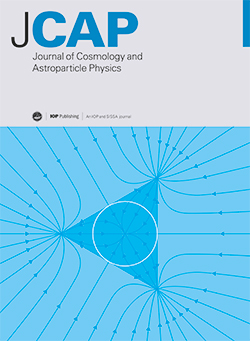BullFrog: multi-step perturbation theory as a time integrator for cosmological simulations
IF 5.3
2区 物理与天体物理
Q1 ASTRONOMY & ASTROPHYSICS
Journal of Cosmology and Astroparticle Physics
Pub Date : 2025-02-11
DOI:10.1088/1475-7516/2025/02/020
引用次数: 0
Abstract
Modelling the cosmic large-scale structure can be done through numerical N-body simulations or by using perturbation theory. Here, we present an N-body approach that effectively implements a multi-step forward model based on Lagrangian Perturbation Theory (LPT) in a ΛCDM Universe. This is achieved by introducing the second-order accurate BullFrog integrator, which automatically performs 2LPT time steps to second order without requiring the explicit computation of 2LPT displacements. Importantly, we show that BullFrog trajectories rapidly converge to the exact solution as the number of time steps increases, at any moment in time, even though 2LPT becomes invalid after shell-crossing. As a validation test, we compare BullFrog against other N-body integrators and high-order LPT, both for a realistic ΛCDM cosmology and for simulations with a sharp UV cutoff in the initial conditions. The latter scenario enables controlled experiments against LPT and, in practice, is particularly relevant for modelling coarse-grained fluids arising in the context of effective field theory. We demonstrate that BullFrog significantly improves upon other LPT-inspired integrators, such as FastPM and COLA, without incurring any computational overhead compared to standard N-body integrators. Implementing BullFrog in any existing N-body code is straightforward, particularly if FastPM is already integrated.求助全文
约1分钟内获得全文
求助全文
来源期刊

Journal of Cosmology and Astroparticle Physics
地学天文-天文与天体物理
CiteScore
10.20
自引率
23.40%
发文量
632
审稿时长
1 months
期刊介绍:
Journal of Cosmology and Astroparticle Physics (JCAP) encompasses theoretical, observational and experimental areas as well as computation and simulation. The journal covers the latest developments in the theory of all fundamental interactions and their cosmological implications (e.g. M-theory and cosmology, brane cosmology). JCAP''s coverage also includes topics such as formation, dynamics and clustering of galaxies, pre-galactic star formation, x-ray astronomy, radio astronomy, gravitational lensing, active galactic nuclei, intergalactic and interstellar matter.
 求助内容:
求助内容: 应助结果提醒方式:
应助结果提醒方式:


